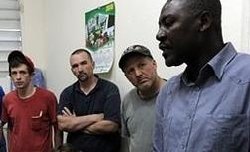The failed attempt by the New Life Children's Refuge to take 33 Haitian children into the Dominican Republic has shed light on the activities of groups that disregard the rules of international 'adoption'.
Even before the earthquake, Haiti was known as a nation of orphans. Now there are countless more.
In the past few weeks, child welfare organizations have been flooded with offers from families in the US and elsewhere willing to adopt children.
And humanitarian agencies say the Idaho-based Christian group New Life Children's Refuge is not the only organization that has been spiriting children away without documentation, 'wanting to give them a better life elsewhere'.
"In these kinds of situations, there are all types of charities and church groups with, to be fair, good intentions," says Richard Danziger, head of counter trafficking at the International Office of Migration (IOM).
"But that's not the way to go about it - it doesn't help an already messy situation. Children with no documentation get whisked away, and their families don't know what has happened to them."
Danziger describes it as "cowboy adoption".
"Not only it is against the law, but it is taking advantage of people in a lousy situation," he said.
Haitian Social Affairs Minister Yves Christallin said: "This is abduction, not adoption."
Rules of engagement
There are clear parallels with the Zoe's Ark case in 2007, when members of a French charity were convicted in Chad of abducting 103 children whom they wrongly claimed had been orphaned in the war in Darfur.
It was a case that embarrassed France. An investigation by the UN found that the children were not orphans and were, in fact, from Chad not Sudan.
Members of the group, Zoe's Ark, insisted "they had been driven by compassion to help the children". Similarly, a member of the New Life Refuge said the children it took from an orphanage in Haiti had been "in need of God's love and compassion".
Ahead of their trial, Zoe's Ark also argued that evacuating children in danger was provided for under the Geneva Convention.
But this approach flies in the face of the rules of engagement followed by the bigger aid agencies, in line with the Hague Convention.
Louise Fulford, care adviser with Save The Children, says the priority is to keep the children within their "communities, their ethnic group and their cultures."
Under the Hague Convention there is a preference for family-based solutions, she says. The second preference is to consider national adoptions, and when these solutions are not feasible then inter-country adoption would be a viable option.
Adoption within the country will be hardest to arrange with children who have health problems, such as HIV/Aids, disabilities, or many siblings. "Unfortunately, with inter-country adoption, it tends to be more the parents choose the child. People tend to want to adopt healthy babies," Fulford says.
UN guidelines stipulate that there should be no national or international adoptions for two years, she adds.
"This provides time to trace relatives. In most emergencies you can trace family members. It will take time. In the meantime, aid agencies are prioritizing children who are unaccompanied - they are being referred to interim care centers. Agencies are working day and night to locate children on their own."
Trafficking
Fulford describes the situation in Haiti as "unique" in terms of the scale of the emergency and of the underlying problems that existed before the emergency.
These problems include a history of child-trafficking and a traditional pattern of families sending children away to live in other, more prosperous households.
"Before the earthquake, the Haitian government estimated that about 2,000 children a year were being trafficked out of Haiti," said Unicef's Roshan Khadivi by phone from Port-au-Prince.
"These children generally ended up being used as domestic labor, being sexually abused or illegally adopted in the US and Canada."
Since the earthquake, the agency has set up five "safe spaces" - their term for temporary orphanages - where children receive food, shelter and psycho-social support, and are kept out of the hands of undesirables.
"This system was first employed in Aceh after the tsunami, and 90% of those children were reunited with family members," says Khadivi.
'Restaveks'
The other problem, of children being sent away by their families, has given birth to a word in the Creole language - restavek, from the French "rester avec, meaning "to stay with".
In some cases, parents believe they are sending their children to legitimate orphanages, though the reality is that they are often put to work, living as virtual slaves. Occasionally children are sold for money.
One estimate suggests that there were 300,000 restavek children in Haiti before the earthquake, so it is easy to understand why some might argue the children would be better off elsewhere.
But experts say it is not that simple, even in the case of families who have a history of sending children into servitude.
"Families acted out of desperation, they may have had no other option," says Save The Children's Louise Fulford.
"It is not because they would choose that lifestyle for that child. Funding should really be available to community and family so that they are not forced to give up their children."
PHOTO CAPTION
Members of Idaho-based charity called New Life Children's Refuge.
Source: BBC


 Home
Home Discover Islam
Discover Islam Quran Recitations
Quran Recitations Lectures
Lectures
 Fatwa
Fatwa Articles
Articles Fiqh
Fiqh E-Books
E-Books Boys & Girls
Boys & Girls  Articles
Articles










